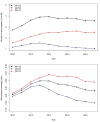10-year opportunistic mammographic screening scenario in Brazil and its impact on breast cancer early detection: a nationwide population-based study
- PMID: 36227588
- PMCID: PMC9564571
- DOI: 10.7189/jogh.12.04061
10-year opportunistic mammographic screening scenario in Brazil and its impact on breast cancer early detection: a nationwide population-based study
Abstract
Background: Mammographic screening has been used to reduce breast cancer mortality worldwide and remains the main modality for the early detection of this disease. Women from low- and middle-income countries still lack access to periodic mammograms and efficient health care. This cross-sectional study aimed to explore opportunistic mammographic coverage in Brazil, while considering the privately insured population and its association with early breast cancer (EBC) detection.
Methods: Data on population, gross domestic product (GDP), number of mammograms performed under the Sistema Único de Saúde (SUS) public health system or private system, and women diagnosed with early-stage breast cancer from 2010 to 2019 were retrieved from publicly available databases.
Results: A total of 39 555 636 mammograms with an average of 3 955 564 ± 395 704 mammograms were obtained per year from 2010 to 2019 in Brazil. Most examinations (58.6%) were performed in the target population (50-69 years old), while 32% were performed in women aged 40-49, and 9.4% were performed in women <40 years or >70 years of age. The 10-year mammogram coverage was 30.6% in the target population and 24.8% in the population aged 40-49 years, with significant variation across states and municipalities. The overall EBC detection rates in Brazil were 30.6% in populations aged 50-70 and 24.8% in those aged 40-50 years. We observed a positive correlation between coverage and EBC detection rate (r = 0.68; P = 0.0001 (50-70 years) and r = 0.75; P < 0.0001 (40-50 years)). According to the GDP, the municipalities with higher GDP per capita had higher mammogram coverage (P < 0.0001).
Conclusions: The coverage of mammographic screening for women under the SUS is far below the international guidelines. Additionally, a significant number of mammograms have been performed in non-target populations. This scenario reflects the problematic screening programs in developing countries and reflects low rates of EBC diagnosis. As Brazil is a continental country with heterogeneous socioeconomic indicators, we observed significant variations in the number of mammograms performed by age groups when separated by states and municipalities. Even when considering supplemental health system coverage, municipalities with higher GDP per capita were associated with higher mammogram coverage.
Copyright © 2022 by the Journal of Global Health. All rights reserved.
Conflict of interest statement
Disclosure of interest: The authors have completed the ICMJE Disclosure of Interest Form (available upon request from the corresponding author) and disclose no relevant interest.
Figures






Similar articles
-
Barriers and facilitators of the implementation of mammography screening in the Brazilian public health system: scoping review.BMC Public Health. 2025 May 6;25(1):1659. doi: 10.1186/s12889-025-22889-9. BMC Public Health. 2025. PMID: 40329235 Free PMC article.
-
Screening mammography for women aged 40 to 49 years at average risk for breast cancer: an evidence-based analysis.Ont Health Technol Assess Ser. 2007;7(1):1-32. Epub 2007 Jan 1. Ont Health Technol Assess Ser. 2007. PMID: 23074501 Free PMC article.
-
Difficult Access and Poor Productivity: Mammography Screening in Brazil.Asian Pac J Cancer Prev. 2019 Jun 1;20(6):1857-1864. doi: 10.31557/APJCP.2019.20.6.1857. Asian Pac J Cancer Prev. 2019. PMID: 31244310 Free PMC article.
-
Performance of a subsidised mammographic screening programme in Malaysia, a middle-income Asian country.BMC Public Health. 2017 Jan 28;17(1):127. doi: 10.1186/s12889-017-4015-3. BMC Public Health. 2017. PMID: 28129762 Free PMC article.
-
Two national mammography quality certification programs in Brazil: Framework and main outcomes between 2017 and 2021.J Cancer Policy. 2023 Dec;38:100437. doi: 10.1016/j.jcpo.2023.100437. Epub 2023 Aug 24. J Cancer Policy. 2023. PMID: 37625468 Review.
Cited by
-
Barriers and facilitators of the implementation of mammography screening in the Brazilian public health system: scoping review.BMC Public Health. 2025 May 6;25(1):1659. doi: 10.1186/s12889-025-22889-9. BMC Public Health. 2025. PMID: 40329235 Free PMC article.
-
Comprehensive diagnosis of advanced-stage breast cancer: exploring detection methods, molecular subtypes, and demographic influences - A cross-sectional study.Clinics (Sao Paulo). 2024 Oct 15;79:100510. doi: 10.1016/j.clinsp.2024.100510. eCollection 2024. Clinics (Sao Paulo). 2024. PMID: 39413498 Free PMC article.
-
Temporal trend of breast cancer burden among younger and older Brazilian women, 1990-2019.Rev Bras Epidemiol. 2025 Mar 3;28:e250006. doi: 10.1590/1980-549720250006. eCollection 2025. Rev Bras Epidemiol. 2025. PMID: 40053004 Free PMC article.
-
Twenty years of breast cancer epidemiology and treatment patterns in São Paulo, Brazil-observed versus expected treatment utilization in a retrospective cohort.Lancet Reg Health Am. 2025 May 7;47:101115. doi: 10.1016/j.lana.2025.101115. eCollection 2025 Jul. Lancet Reg Health Am. 2025. PMID: 40476049 Free PMC article.
-
Differences in breast cancer survival and stage by age in off-target screening groups: a population-based retrospective study.AJOG Glob Rep. 2023 Apr 11;3(2):100208. doi: 10.1016/j.xagr.2023.100208. eCollection 2023 May. AJOG Glob Rep. 2023. PMID: 37213794 Free PMC article.
References
MeSH terms
LinkOut - more resources
Full Text Sources
Medical
Research Materials
